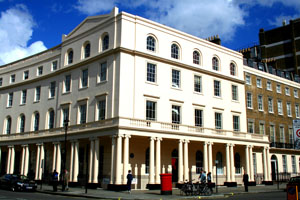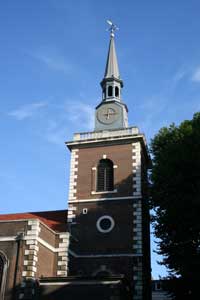Arklow House, Connaught Place:
This was the headquarters of the London branch of the Southern Independence Association (there were 47 branches across the UK). This group aimed to force Parliament to recognize the Confederacy as an independent nation for the sake of Britain’s economic ties with the South (cotton, tobacco & tea trading). The SIA was also motivated by the speedy growth of the US as a world power in the 1860s, and many members felt cutting America in half would safeguard the future of the British Empire. Members of the SIA included a future Prime Minister, 1 cabinet member, 19 Members of Parliament, 34 peers, numerous academics, judges, doctors, and other elite members of Victorian British society.
 Washington Legation, Mansfield Street:
Washington Legation, Mansfield Street:
The term ’embassy’ did not exist in 1861, and the headquarters of the US interest in London was referred to as the Washington Legation. The US Minister to London was Charles Francis Adams (direct descendant of 2 US presidents). Lincoln hand-picked Adams for this position for several reasons. Adams had an English mother and Charles lived in London when John Quincy Adams was the US Minister to London decades earlier. Lincoln, therefore, felt Adams had a strong understanding of the British and their way of thinking. Furthermore, with Secretary of State William Seward’s well-known anti-British sentiments, Lincoln understood the need for a ‘moderate’ representative of his administration in London. Furthermore, considering Seward’s hostile tone towards the British, Lincoln ordered that all of Seward’s correspondence with the British Foreign Office be sent to this address for Adams to, if necessary, to rewrite so as to remove any potentially hostile rhetoric. Adams’ soft tone was a key element in Lincoln’s campaign to keep Britain out of the war and, therefore, securing the ultimate Union victory.
Washington Legation (1863-1866), Portland Place:
In 1863, Charles Francis Adams decided that the offices in Mansfield Street were insufficient, and moved the legation to this much larger office. The US Minister continued to live at the old address, though his son and secretary, Henry, moved into this address.
Confederate Commercial Agency, Savile Row:
In 1861 the Confederate Government named Alabamian Henry Hotze as Commercial Agent, responsible for infiltrating mainstream British newspapers so as to make them pro-South. Realising how much support the Confederacy had amongst Britain’s upper classes, Hotze suggested the Confederate Government print its own newspaper in London to help hasten an Anglo-Confederate alliance, giving birth to The Index the following year. Hotze orchestrated nearly all Confederate commercial business in Europe from this building. After Richmond was evacuated in April 1865, Secretary of State Judah P. Benjamin escaped to London and arrived unannounced at this address.
Fleet Street: Office of The Index:
What is today the Dry Cleaning Express was the office of The Index. Although this propaganda journal was funded by the Confederate Government, its writing staff was mostly English. The newspaper capitalized on anti-British sentiments in the North and controversial acts committed by Union forces in occupied areas of the South to garner support in the upper classes of British society. However, its blatantly pro-slavery rhetoric, combined with frequent attacks on the British Foreign Secretary for a lack of action against Lincoln, limited its appeal in the later stages of the war. Regardless, subscribers included numerous Members of Parliament, and even the Prime Minister’s private secretary.
Fleet Street: Office of The London American:
The London American was the pro-Union propaganda journal situated just two doors down from The Index on the site of today Timpson’s shoe reparing shop. Unlike their Southern counterparts, the Yankee journal had a 100% American writing staff, including its editor John Adams Knight (of whom very little is known). The journal was anti-abolition until the Emancipation Proclamation came into effect, and tended to follow Lincoln’s agenda verbatim throughout the war. Its major setback was the frequent assaults on British society, government, monarchy and established church, even becoming openly hostile at times. As a result, subscriptions to this journal was mostly limited to the working classes and radical groups, such as the London Emancipation Society. Owing to poor financial management and general unpopularity, The London American stopped printing in March 1863. The Index continued to be published through August 1865.
St. Peter’s Church, Belsize Square:
Nicknamed during the war, ‘The Confederate Parsonage’ owing to its near-weekly pro-Southern sermons delivered by Rev. Francis Tremlett, secretary of the Society for Promoting a Cessation of Hostilities in America, and the churches wardens were also patrons of this organization. The group consisted almost entirely of Church of England clergymen and stated that they favored Britain’s intervening into the war in the name of peace, though this was a well-known Anglo-Confederate organization. After the CSS Alabama sank in the English Channel, Capt. Rafael Semmes stayed at Tremlett’s house across the street from the church (Semmes was rescued by a British ship after the fight), along with Matthew Fontaine Maury. After the war in 1868, Jefferson & Varina Davis spent Christmas Eve with Tremlett and attended Midnight Eucharist at the church. Other ex-Confederate visitors Tremlett received after the war included P.G.T. Beauregard and one of Robert E. Lee’s daughters.
Confederate States Aid Association Headquarters, Devonshire Street:
Under the leadership of Dr Charles Lempriere, an English physician, this society worked closely with Confederate purchasing agents Caleb Huse and Matthew Fontaine Maury to purchase and ship war munitions through the blockade to the Confederates during the first two years of the war. Members of the London Emancipation Society raided a meeting at this address in 1862, resulting in the police arresting the intruders, which included W.A. Jackson, a runaway slave of Jefferson Davis.
Lord Palmerston’s Home:
The home of the Prime Minister from 1859-1865. The Society for Promoting a Cessation of Hostilities in America sent a deputation of Church of England clergymen to this address in the summer of 1864 to plea to Palmerston to mediate between the North & South, create an armistice and negotiate a separation between the two sides. The Prime Minister stated that he agreed in sentiment, but felt that trying to intervene after three years of fighting would be like ‘preaching to mad dogs’. A March 1865 meeting between Confederate agent Duncan Kenner and Palmerston also took place here, with Kenner presenting Richmond’s offer to end slavery in return for British intervention into the war. The Prime Minister said Britain would remain neutral, and informed him that slavery was never the reason for this stance taken by the British throughout the war.
Richmond Legation, Half Moon Street:
The home and office of Alabamian William Yancey, the Confederate Commissioner to London from 1861-62. Yancey was deemed incompetent as a diplomat after his first few months in office, owing to his frequently expressing ardent pro-slavery sentiments in Britain, where slavery was largely detested. Yancey went so far as to suggest that Britain and the Confederacy work together to re-open the transatlantic slave trade, which was possibly the most unpopular proposal ever made in London by a foreign diplomat. The Confederate Government, therefore, recalled Yancey and replaced him with James Murray Mason of Virginia.
Greenhow Residence, Sackville Street:
The home of famed Confederate spy Rose O’Neal Greenhow. Owing to her espionage acts in the First Manassas Campaign, she was imprisoned for treason against the US. Released in 1862, she was sent as a diplomatic agent to Europe. At this London address, she wrote, Imprisonment and the First Year of Abolition Rule at Washington, which proved very popular in England. The earnings from book sales were intended for the Confederate Treasury, and in September 1864 she boarded a British blockade runner for Wilmington. Being pursued by a US Navy gunboat, Greenhow attempted to escape in a rowboat upon entering the Cape Fear River, but the decision to place $2,000 worth of gold in a sack around her neck proved fatal when the boat capsized.
 St. James’s Church, Piccadilly:
St. James’s Church, Piccadilly:
After being arrested as a spy on three occasions, Belle Boyd moved to London in 1864, where she began a mediocre acting career. That same year she married Samuel Wylde Hardinge, a US Navy officer, at this church. Hardinge died just two years later, prompting Boyd to move back to the United States.
Society for Promoting a Cessation of Hostilities in America, Regent Street:
This facade of this building, currently a Barkers shoe shop, has been reconstructed since the 1860s when this was the headquarters of Reverend Francis Tremlett’s society’s pro-Confederate activities. After the unsuccessful proposal made to Lord Palmerston in the summer of 1864, this group became largely inactive.
Lincoln’s Inn, Chancery Lane:
After Confederate Secretary of State Judah P. Benjamin’s arrival in London in 1865, he became a barrister at Lincoln’s Inn at the recommendation of Index writer John George Witt, himself a member at the Inn. As a legal attorney, Benjamin worked on several postbellum Civil War-related cases, including the Alabama claims, where Britain was forced to pay for the damages she and other British-built Confederate cruisers committed against the US merchant fleet. In 1883, Benjamin retired from practicing law and moved to Paris, where he died the following year.




